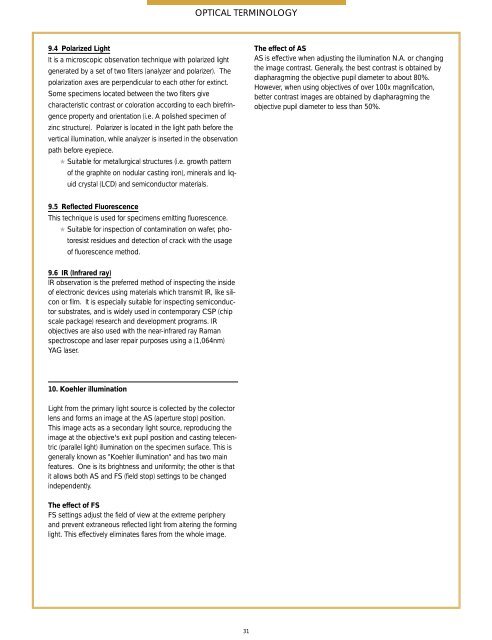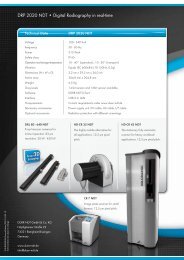INDUSTRIAL MICROSCOPES
INDUSTRIAL MICROSCOPES
INDUSTRIAL MICROSCOPES
Create successful ePaper yourself
Turn your PDF publications into a flip-book with our unique Google optimized e-Paper software.
9.4 Polarized Light<br />
It is a microscopic observation technique with polarized light<br />
generated by a set of two filters (analyzer and polarizer). The<br />
polarization axes are perpendicular to each other for extinct.<br />
Some specimens located between the two filters give<br />
characteristic contrast or coloration according to each birefringence<br />
property and orientation (i.e. A polished specimen of<br />
zinc structure). Polarizer is located in the light path before the<br />
vertical illumination, while analyzer is inserted in the observation<br />
path before eyepiece.<br />
★ Suitable for metallurgical structures (i.e. growth pattern<br />
of the graphite on nodular casting iron), minerals and liquid<br />
crystal (LCD) and semiconductor materials.<br />
9.5 Reflected Fluorescence<br />
This technique is used for specimens emitting fluorescence.<br />
★ Suitable for inspection of contamination on wafer, photoresist<br />
residues and detection of crack with the usage<br />
of fluorescence method.<br />
9.6 IR (Infrared ray)<br />
IR observation is the preferred method of inspecting the inside<br />
of electronic devices using materials which transmit IR, like silicon<br />
or film. It is especially suitable for inspecting semiconductor<br />
substrates, and is widely used in contemporary CSP (chip<br />
scale package) research and development programs. IR<br />
objectives are also used with the near-infrared ray Raman<br />
spectroscope and laser repair purposes using a (1,064nm)<br />
YAG laser.<br />
10. Koehler illumination<br />
Light from the primary light source is collected by the collector<br />
lens and forms an image at the AS (aperture stop) position.<br />
This image acts as a secondary light source, reproducing the<br />
image at the objective's exit pupil position and casting telecentric<br />
(parallel light) illumination on the specimen surface. This is<br />
generally known as "Koehler illumination" and has two main<br />
features. One is its brightness and uniformity; the other is that<br />
it allows both AS and FS (field stop) settings to be changed<br />
independently.<br />
The effect of FS<br />
FS settings adjust the field of view at the extreme periphery<br />
and prevent extraneous reflected light from altering the forming<br />
light. This effectively eliminates flares from the whole image.<br />
OPTICAL TERMINOLOGY<br />
31<br />
The effect of AS<br />
AS is effective when adjusting the illumination N.A. or changing<br />
the image contrast. Generally, the best contrast is obtained by<br />
diapharagming the objective pupil diameter to about 80%.<br />
However, when using objectives of over 100x magnification,<br />
better contrast images are obtained by diapharagming the<br />
objective pupil diameter to less than 50%.



